

Facebook Twitter Flickr YouTube RSS Feed
Written on: May 29th, 2013 in Archaeology Updates, US301
Watch as Michael Carmody, Archaeologist, from Dovetail Cultural Resource Group gives a final update on the excavations at the Warwick Native American Archaeology site.
Written on: May 21st, 2013 in Archaeology Updates, US301
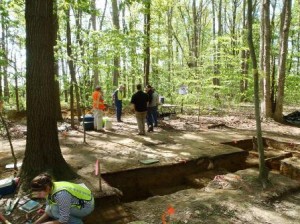
On May 3, representatives from the Maryland Historic Trust (MHT), the Federal Highway Administration (FHWA) and the Delaware Department of Transportation (DelDOT) visited the Warwick Site. Planned improvements to Route 301 led to the excavation of the site, and, in turn, to coordination with various state and federal agencies. Near the Warwick Site, Route 301 narrows from a two-lane road in Maryland to one lane in Delaware; therefore, DelDOT’s road widening will extend a short distance into Maryland to avoid creating a bottleneck near the state line. Coordination with both states was required to ensure the work meets the requirements of both state agencies, as well as the FHWA. Since excavation destroys the archaeological record at the same time information is collected, meeting with representatives on site allowed the participants to examine the ongoing work directly rather than filtered through Dovetail’s documentation and interpretation.
At the meeting, DelDOT, thanked everyone for coming and turned the meeting over to Dovetail Cultural Resource Group (Dovetail) for an overview of the site. Mike Carmody of Dovetail presented an overview of the excavation strategy, and discussed public outreach. Mike Klein, Dovetail archaeologist, then described the specific results of the excavation, including an overview of the vertical and horizontal distribution of artifacts, the type of artifacts recovered, and the approach to excavation. Conversation with the agency representatives clarified aspects of the excavation and the ongoing research and analysis. The meeting concluded with FHWA and MHT staff engaging the Dovetail field crew, who continued the fieldwork throughout the meeting.
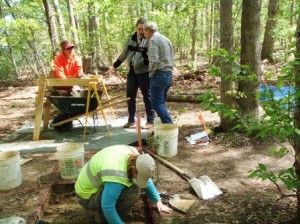
Written on: May 14th, 2013 in Archaeology Updates, US301
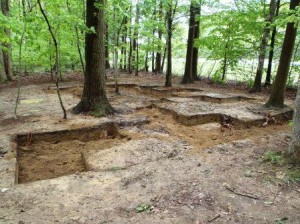
Phase III fieldwork at the Warwick Site ended on May 9th, with the completion of 33 test units. Fifty-nine square meters, or roughly 635 square feet, were excavated during the Phase I through III fieldwork. All artifacts have been returned to the lab for cleaning and detailed analysis. The artifacts will be measured, weighed, and classified by type of stone, reduction stage, and shape. Reduction stage refers to extent to which tools have been shaped and thinned, and to the point in tool manufacturing when flakes were removed. For example, during the initial stage, as the tool is roughly shaped, flakes tend to be large and the weathered exterior of the stone, termed the cortex, is often present. In contrast, sharpening a finished tool tends to produce small flakes that lack cortex on the flake. In addition, points will be classified by reference to standard sources, like William Ritchie’s A Typology and Nomenclature for New York Projectile Points and Noel Justice’s Stone Age Spear and Arrow Points of the Midcontinental and Eastern United States; on-line information posted by Delaware’s Historic Preservation Office (http://history.delaware.gov/archaeology/points/start.shtml) and Maryland’s Jefferson Patterson Park and Museum will also be consulted (http://www.jefpat.org/diagnostic/Maryland_Projectile_Points/index-projectilepoints.html). The information will then be typed into a data base for analysis.
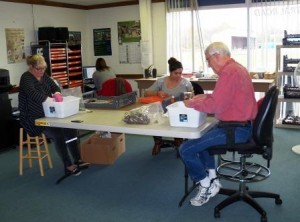
Written on: May 14th, 2013 in Archaeology Updates, US301
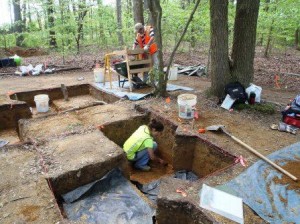
The previous post characterized the Warwick Site as a way station where small groups monitored game trails, sharpened tools, and consumed packed snacks, locally available foods, or both; ongoing excavation of the Warwick Site has reinforced this assessment. Nevertheless, the more robust view of the spatial distribution of artifacts across the site revealed by newly excavated test units highlights variation in the density and location of different types of artifacts and, perhaps, different activities, and has implications for the length and type of past occupations. Within the core of the site, for example, artifact density reached 30 to 65 artifacts per test unit, well above the amount recovered from most test units. In contrast, very few artifacts occurred in the southeastern test units, though several tools were unearthed in that area and a small basin-shaped pit was identified during the earlier work. The pit contained only charcoal and very small fragments of chipping debris that would have fallen through the screens used to standardize artifact collection. Microdebitage, the archaeological term for the very small chips recovered by passing the sediments from the feature through screens similar to mosquito mesh, may be one key to evaluating the way-station hypothesis.
Two ethnographic observations illustrate the value of microdebitage: 1) people maintain sleeping and common areas by relocating large debris to the unused portions of the landform; and 2) the extent of maintenance and the organization of space tend to correlate with length of stay at a location. While cleaning, people often overlook extremely small fragments of chipping debris. If, therefore, flintknappers sharpening tools created the artifact-rich core of the site, microdebitage should be present. The absence of very small debris implies that larger material was tossed or swept from the actual location where tools were manufactured. Similarly, if a dearth of microdebitage does not accompany the dearth of refuse in the southeastern corner of the excavation block, the proposed interpretation flounders. The presence of significant amounts of microdebitage in an artifact-poor area implies extensive cleaning around the pit feature. The level of maintenance and spatial organization implied by extensive cleaning of a living area suggests a longer-term occupation that required more extensive organization of the use of space than predicted by the way-station hypothesis. Consequently, samples collected from the test units will be screened through fine mesh and examined under low magnification to assess the presence and frequency of microdebitage in different portions of the site.
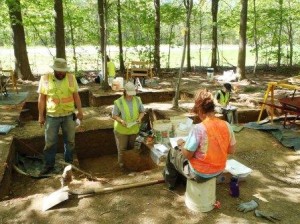
Written on: May 6th, 2013 in Archaeology Updates, US301
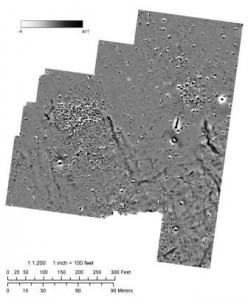
The next task in the ongoing study of the Dale Site is to make write a detailed report on the archaeological findings. Looking back over the work that we did, one of the most interesting items was the geophysical study we made of the site. Archaeologists are always looking for new ways to find out what is under the ground. Hand excavation is slow and expensive, and excavation with a machine is destructive. The problem is especially vexing at the testing level, what we call Phase II. Before we commit money and time to excavating a site, we would like to know if our efforts will be repaid by significant finds below ground, things like building foundations and pits full of artifacts. But how to learn that without either putting weeks into hand digging through plowed soils, or stripping that plowed soil away with a backhoe?
Science comes to the rescue here. Physicists and engineers have developed several methods of peering into the ground to find out what is there, of which the most basic is the old-fashioned metal detector. Surface-penetrating radar is one exciting new method, which has been especially useful for finding cemeteries and graves. At the Dale Site we used another method, high-resolution magnetometry. By measuring minute variations in the earth’s magnetic field, this machine can find many kinds of buried objects, including stone or brick foundations and concentrations of metal like the nails from a wooden building. The raw data that came from our magnetometer study is shown at the top. Below is an interpreted map of the same data. The red regions are places where buildings probably stood, and green dot No. 3 turned out to be a well. Using this data, we were able to zero in on the places where the most interesting discoveries could be made below the surface, saving a lot of time and money.

Written on: May 3rd, 2013 in Archaeology Updates, US301
Watch as Mike Klein, Archaeologist, from Dovetail Cultural Resource Group discusses the excavations at the Warwick Native American Archaeology site for the US RT 301 project.
Written on: May 3rd, 2013 in Archaeology Updates, US301
Watch as Michael Carmody, Archaeologist, from Dovetail Cultural Resource Group gives an update on the excavations at the Warwick Native American Archaeology site.
Written on: May 3rd, 2013 in Archaeology Updates, US301
Continuing work at the Warwick Site completed the excavation of roughly half of the open units. Plowing, among other processes, appears to have obliterated any evidence for structures, hearths, or storage pits. For the most part, artifacts occurred in the plow zone and the uppermost portion of the subsoil. Below that depth, artifact density dropped precipitously, with only a few small pieces of sharpening debris from stone tools were recovered per level. Although archaeological sites exhibiting a layer-cake accumulation of living surfaces from different periods of time are known in the northern Delmarva Peninsula, plowing, burrowing, and roots likely explain the artifacts recovered below the uppermost portion of the subsoil at the Warwick Site. .
Various point forms traditionally assigned to the Late Archaic and Early Woodland periods, similar to those recovered during the earlier fieldwork, have been recovered. Yellowish brown jasper appears to predominate, though red jasper, gray chert, quartz, and quartzite have been recovered. Tools include a few bifaces and unifaces, the latter including a few with tools with steep edge angles typical of hide scrapers. Scattered fire-cracked rock has been recovered; the sole potential feature, however, is three fired rock fragments at the interface between the plow zone and subsoil. The generally low artifact density and predominance of small sharpening flakes seems consistent with tool sharpening and limited food preparation by small groups during short-term stays, the sort of behavior described by studies of locations where modern Arctic hunters monitor game trails. Further excavation during the next session of fieldwork, of course, could identify a long-buried deposit of artifacts, the remains of shelters and hearths, or areas where different types of artifacts cluster.